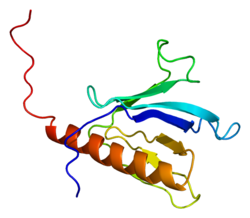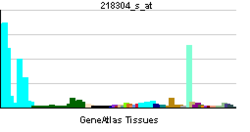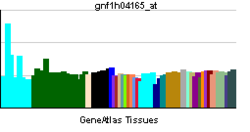- OSBPL11
-
Oxysterol binding protein-like 11 
PDB rendering based on 2d9x.Available structures PDB 2d9x Identifiers Symbols OSBPL11; FLJ13012; FLJ13164; ORP-11; ORP11; OSBP12; TCCCIA00292 External IDs OMIM: 606739 MGI: 2146553 HomoloGene: 23385 GeneCards: OSBPL11 Gene Gene Ontology Molecular function • lipid binding Biological process • transport
• lipid transportSources: Amigo / QuickGO RNA expression pattern 

More reference expression data Orthologs Species Human Mouse Entrez 114885 106326 Ensembl ENSG00000144909 ENSMUSG00000022807 UniProt Q9BXB4 Q8CI95 RefSeq (mRNA) NM_022776 NM_176840.3 RefSeq (protein) NP_073613 NP_789810.2 Location (UCSC) Chr 3:
125.25 – 125.31 MbChr 16:
33.19 – 33.24 MbPubMed search [1] [2] Oxysterol-binding protein-related protein 11 is a protein that in humans is encoded by the OSBPL11 gene.[1]
This gene encodes a member of the oxysterol-binding protein (OSBP) family, a group of intracellular lipid receptors. Like most members, the encoded protein contains an N-terminal pleckstrin homology domain and a highly conserved C-terminal OSBP-like sterol-binding domain.[1]
References
Further reading
- Andersson B, Wentland MA, Ricafrente JY et al. (1996). "A "double adaptor" method for improved shotgun library construction". Anal. Biochem. 236 (1): 107–13. doi:10.1006/abio.1996.0138. PMID 8619474.
- Yu W, Andersson B, Worley KC et al. (1997). "Large-Scale Concatenation cDNA Sequencing". Genome Res. 7 (4): 353–8. doi:10.1101/gr.7.4.353. PMC 139146. PMID 9110174. http://www.pubmedcentral.nih.gov/articlerender.fcgi?tool=pmcentrez&artid=139146.
- Lehto M, Laitinen S, Chinetti G et al. (2001). "The OSBP-related protein family in humans". J. Lipid Res. 42 (8): 1203–13. PMID 11483621.
- Jaworski CJ, Moreira E, Li A et al. (2002). "A family of 12 human genes containing oxysterol-binding domains". Genomics 78 (3): 185–96. doi:10.1006/geno.2001.6663. PMID 11735225.
- Strausberg RL, Feingold EA, Grouse LH et al. (2003). "Generation and initial analysis of more than 15,000 full-length human and mouse cDNA sequences". Proc. Natl. Acad. Sci. U.S.A. 99 (26): 16899–903. doi:10.1073/pnas.242603899. PMC 139241. PMID 12477932. http://www.pubmedcentral.nih.gov/articlerender.fcgi?tool=pmcentrez&artid=139241.
- Ota T, Suzuki Y, Nishikawa T et al. (2004). "Complete sequencing and characterization of 21,243 full-length human cDNAs". Nat. Genet. 36 (1): 40–5. doi:10.1038/ng1285. PMID 14702039.
- Beausoleil SA, Jedrychowski M, Schwartz D et al. (2004). "Large-scale characterization of HeLa cell nuclear phosphoproteins". Proc. Natl. Acad. Sci. U.S.A. 101 (33): 12130–5. doi:10.1073/pnas.0404720101. PMC 514446. PMID 15302935. http://www.pubmedcentral.nih.gov/articlerender.fcgi?tool=pmcentrez&artid=514446.
- Gerhard DS, Wagner L, Feingold EA et al. (2004). "The Status, Quality, and Expansion of the NIH Full-Length cDNA Project: The Mammalian Gene Collection (MGC)". Genome Res. 14 (10B): 2121–7. doi:10.1101/gr.2596504. PMC 528928. PMID 15489334. http://www.pubmedcentral.nih.gov/articlerender.fcgi?tool=pmcentrez&artid=528928.
- Beausoleil SA, Villén J, Gerber SA et al. (2006). "A probability-based approach for high-throughput protein phosphorylation analysis and site localization". Nat. Biotechnol. 24 (10): 1285–92. doi:10.1038/nbt1240. PMID 16964243.
- Olsen JV, Blagoev B, Gnad F et al. (2006). "Global, in vivo, and site-specific phosphorylation dynamics in signaling networks". Cell 127 (3): 635–48. doi:10.1016/j.cell.2006.09.026. PMID 17081983.
PDB gallery Categories:- Human proteins
- Chromosome 3 gene stubs
Wikimedia Foundation. 2010.

